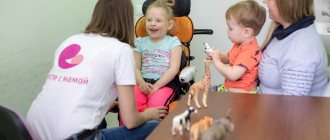Article “Sand therapy in the work of a speech therapist”
The use of sand therapy in the work of a speech therapist.
Speech therapist teacher: Pleshanova S.B.
2017
Sand therapy in the work of a speech therapist
I have been using sand therapy since September 2014. First, I studied theoretical material on the topic (books, magazines, Internet resources). Then I worked on creating the necessary development environment. To do this, I needed the necessary equipment: 1. Waterproof wooden box. The inner surface (bottom and sides) is painted blue or light blue. Thus, the bottom will symbolize water, and the sides will symbolize the sky. If you work in a subgroup (3-4 people) or individually, its size is 50 x 70 x 8 cm; for group work, the size of the sandbox increases. This size of the box corresponds to the optimal field of visual perception, and this allows you to cover it entirely with your gaze. 2. Clean, sifted sand. It should not be too large or too small. A smaller part of the box is filled with sand. For sand games it is better if it is wet. Thus, the sand symbolizes the “horizon line.” 3. Colored sand. Preschoolers respond emotionally to vivid impressions, therefore, colored sand is necessary. 4. Colored sea salt. Preferably large - it can be used to develop fine motor skills. 5. “Collection” of miniature figures (their height is no more than 8 cm) The set of toys may include: *Human characters *Animals (domestic, wild, prehistoric, marine, etc.) *Transport (land, water, space, etc.) .) *Plants (trees, bushes, flowers, vegetables, etc.) *Natural objects (shells, twigs, stones, bones, eggs, etc.) *Fairy tale characters (evil and good) *Waste material *Plastic or wooden letters and numbers, various geometric shapes (circles, triangles, rectangles, pyramids, etc.) In a word, everything that is found in the surrounding world can take its rightful place in the “collection”. Collecting equipment for games will not be burdensome, since today every child will help with this (with figures from Kinder Surprise, parts of construction sets, etc.).
The very principle of sand therapy was proposed by Carl Gustav Jung, a remarkable Swiss psychologist and philosopher, the founder of analytical therapy. Sand therapy is a type of play therapy. The main advantages of the sand play therapy method in correctional and developmental work: * develops tactile-kinesthetic sensitivity and fine motor skills of the hands, which are directly related to mental operations (the child receives tactile sensations through the skin: hot - cold, dry - wet, hard - soft, kinesthetic sensations obtained while moving) *motivation and interest in correctional and developmental activities significantly increases (on the one hand, the child attends the lesson with pleasure because he is playing, on the other hand, he has no fear of making mistakes, since mistakes in the sand are easier to correct than on paper - this gives the child confidence, he feels successful); *the emotional state of children is stabilized, their performance remains longer (sand has the property of absorbing negative mental energy, interaction with it cleanses a person’s energy); *the vocabulary of words is expanded, the skill of coherent utterance is developed, phonemic hearing and perception are developed, and the skills of sound-syllable analysis and synthesis are mastered; the skill of correct sound pronunciation is consolidated (when a child plays with sand, he talks about his feelings, he pronounces what he did, imitates the characters, enters into dialogue); * all cognitive functions (perception, attention, memory, thinking) develop more harmoniously and intensively, and most importantly for us – speech and motor skills; The child’s communication skills are improved. Based on the methods of working in the pedagogical sandbox, I try to make the traditional methodology for working on the sound culture of speech, on the phonetic-phonemic side of speech, and the development of coherent speech in children with general speech underdevelopment more interesting, exciting, and more productive.
Five steps to organizing the gameplay.
The first step is to demonstrate the sandbox. We usually tell children the following. “Look, our sandbox is half filled with sand, so the blue sides are visible. Why do you think this is necessary? Indeed, boras symbolize the sky. The sandbox has another secret: if you and I part the sand, we will find a blue bottom. Why do you think this is necessary? Indeed, the bottom symbolizes water. You can create a river, lake, sea and even an ocean. And with the help of a jug of water, dry sand easily turns into wet sand. In short, everything here is subject to your imagination.”
The second step is to demonstrate the collection of figurines. Usually we tell children the following. “Look at a lot of different figures here. You can look at them and hold them in your hands. There are trees, houses, people, and much more. When creating your own world, your own picture in the sandbox, you can use different figures.”
The third step is getting to know the rules of sand games. Very often teachers ask such questions. “How to teach children to be careful with sand? How to stop throwing sand in the eyes of your comrades? How can we explain that it is impossible to destroy what others have created?” Indeed, playing with sand puts forward a significant number of restrictions and prohibitions. To avoid moralizing, we recommend introducing children to the rules in the context of some kind of ritual, a constantly repeated action in which these rules are lived and played out.
The fourth step is the formulation of the topic of the lesson, instructions for games, the main content of the lesson. This step is carried out by a fairy-tale character (Sand Man, Fairy, Tortila the Turtle, etc.). He sets the topic of the lesson, on his behalf a fascinating story is told about some event, he formulates tasks and asks riddles. In other words, all educational material is presented to children by this fairy-tale character. He leads the game process, controls its progress, summarizes and analyzes the results of creative work, “crowns” and encourages each of the guys.
Fifth step - completion of the lesson, exit ritual Having completed work in the sandbox, the children dismantle their buildings, place the toys on the shelves; They level the sand, place their palms on the surface of the sand and say words of gratitude.
Thus, activities conducted in the sandbox make the correctional and developmental process creative, interesting, bringing the joy of discovery and pleasure to children. Experience has shown that the use of sand therapy gives positive results: - children's interest in speech therapy classes increases significantly; — delivered sounds are successfully automated and differentiated; — the dictionary is replenished and activated; — the grammatical structure of speech and coherent speech are corrected; — reading and writing skills are formed; — fine motor skills develop; In the future I plan to: replenish the equipment and create an album of photographs.
CARD FILE OF GAMES AND EXERCISES ON THE USE OF SAND THERAPY
Development of breathing. Before starting work on developing breathing, it is necessary to teach children the following rules, using game moments: - “Take in air through your nose, without raising your shoulders, and inflate your stomach with a “ball.” Exhale slowly and smoothly. Try to blow so that the air stream is very long; - “Smooth the road” - from the children’s car, the speech therapist makes a shallow groove in the sand, the child uses an air stream to level the road in front of the car; - “What’s under the sand?” - the picture is covered with a thin layer of sand. Blowing away the sand, the child opens the image; - “Pit” - the child, following the rules of breathing, takes in air through the nose, inflating the stomach and slowly, smoothly, in a long stream, blows out a hole in the sand; - “Help the hare” - three or four depressions are made in the sand - “footprints” leading to the toy hare. There is a fox nearby. It is necessary to “cover up” all traces so that the hare is not discovered; “The road to a friend” - two toys are placed on the sand. You need to use a long, smooth stream to form a path on the sand from one toy to another; - “Secret” - a toy or small object is buried shallowly in the sand. It is necessary to blow off the sand to reveal what is hidden; - “Storm” - a hole is dug in the wet sand and filled with water. A child causes a “storm” with a long-lasting strong air stream
Regulating muscle tone, relieving tension in the muscles of the fingers, improving fine motor skills - place your palms on the sand or in the water, feel the fingers completely relax. — immerse your fingers in the sand or water, clench and unclench your fists. — immerse your fingers in the sand or water, squeeze and unclench alternately the little finger and the thumb on one hand, on both hands at the same time. — immerse your fingers in the sand or water and create “waves” with light movements.
Articulation exercises - “Horse” - click your tongue, at the same time rhythmically with your fingers, in time with the clicks, “jump on the sand” or on the water. - “Turkeys” - quickly lick the upper lip with the tongue with the sound “bl-bl-bl”, move your fingers in time with the movements of the tongue in the thickness of the sand or through the water. - “Swing” - rhythmically move the tongue up and down, move the index finger of the leading hand along the sand or water in the same direction in time with the movements of the tongue. - “Watch” - rhythmically move the tongue left and right, with the index finger of the leading hand in time with the movements of the tongue in the same direction along the sand or in the water. - “Punish the naughty tongue” - with your lips rhythmically spank the protruding tongue with the sounds “five-five-five”, lightly pat the sand with the palms of both hands.
Automation of sounds
- “Strong motor” - pronounce the sound [p], tracing a path along the sand with your index finger. A variation of this exercise is to draw the letter P on the sand or water, pronouncing the sound [P] at the same time. You can work similarly with other sounds, combining writing a letter with pronouncing the sound.
- “Weak motor” - pronounce [P] (soft), tracing a path with your little finger along the sand and water.
- “Gorochka” - take sand or water into your hand and pronounce the sound C, pouring a hill (or pouring water from your palm). A variation of this exercise is to choose a toy with the sound C from the toys lying or half-buried in the sand and, having collected sand and pronouncing the sound, fill it up.
- “Path” - pronounces the syllables assigned by the speech therapist, “walking” them with a finger or lightly spanking them on the sand or water with his palms.
- “Coincidence” - the speech therapist buries toys with the sound [Ш] in the sand: a mouse, a bear, a matryoshka doll, a cat so that the toy in the sand is indicated by a low mound. Then he invites the child to remember toys whose names contain the sound [Ш]. A child names a toy and digs up sand. If the dug up toy coincides with the one named by the child, then he gets the opportunity to play with this toy.
Development of phonemic hearing
- “Funny hide and seek” - hide your palms in the sand after hearing a given sound. For other sounds, hold your hands over the sandbox.
- “Sand Rain” - the speech therapist teacher pronounces syllable combinations, then words, and the child, repeating them, pours sand from palm to palm. Syllable combinations: ba-pa, ta-da, sa - for, ma - na - ma, yes - ta - yes. Words: cat - year - cat; tom – house – com; fable - tower - arable land.
- “Housewarming” - two houses are drawn in the sandbox. Toy animals are hidden under a thick layer of sand. The child digs them up and resettles them in different houses (for example, in “house C” and “house W”).
Formation of the syllable structure of the word - “Name the object” - the speech therapist teacher puts toys in the sandbox. Then he invites the child to dig one hole near an object whose name has one syllable, dig two holes near an object whose name has two syllables, etc. — “Fun Train” - a speech therapist teacher draws a train in the sand with a steam locomotive and three carriages in which toy passengers (for example, a wolf, a cow, a goat, a dog, a squirrel, a chicken) will travel, each in their own carriage. In the first - those whose names have one syllable, in the second - two, in the third - three syllables. - “Correct the mistake” - the speech therapist draws an erroneous number of stripes in the sand. The child analyzes the number of syllables in a word and corrects the error by adding or removing an extra strip. - “Divide the word into syllables” - the child prints the given word (or a self-selected word) on the sand and divides it into syllables with vertical stripes.
Improving the grammatical structure of speech - “Who knows more words?” (for selection and agreement of nouns with adjectives). The child discovers various objects or toys hidden in the sand and selects adjectives for their names, matching them in gender with the nouns (cucumber - oval, green; Christmas tree - plastic, prickly, etc.). - “Recount” - (to coordinate nouns with ordinal numbers). Before class, the speech therapist teacher hides toys in the sand and invites the child to dig them up and count them (the first car, the second boat, etc.) - “Arrange the toys” (for the use of prepositions “FOR”, “BEFORE”, “BETWEEN” in speech) ). The speech therapist teacher invites the child to seat the guests at Bunny’s birthday party, pronouncing his actions (behind the doll is a puppy, in front of the doll is a baby elephant, etc.) - “One-many” (for the use of nouns in the genitive plural). The speech therapist teacher invites the child to sprinkle sand on objects, pronouncing his actions (one cup - many cups, one saucer - many saucers, etc.)
Sound analysis of words and sentences You can draw diagrams of words and sentences of varying degrees of complexity in the sand. - “The word has crumbled.” The child writes or looks for different letters in the sand, then makes words from them. - “Magic transformations.” The speech therapist teacher invites the children to write a word (1, 2 syllables), and then turn it into another, replacing one sound (letter) (cancer-poppy). - “Secret letter”. A speech therapist teacher draws diagrams of sentences of varying degrees of complexity in the sand. Children come up with appropriate sentences. Then the speech therapist pronounces a sentence, and the children draw a corresponding diagram.
Literacy training - “Write in the sand” - the child writes the given letters, syllables and words, and the speech therapist reads them. The reverse option is also allowed: the speech therapist writes, and the child reads. Children 7 years old can be asked to write a short word (with one syllable) in the sand, omitting the first, last letter or the letter in the middle of the word. The speech therapist guesses the word conceived and written by the child.
Development of coherent speech When drawing a sand picture, you can practice the ability to construct both simple and complex sentences. - “Complete the picture and make a sentence” - the speech therapist draws a ball, jump rope, balloon or other objects in the sand. The child’s task is to complete the sand picture and make a sentence based on it. (“Tanya is holding a balloon in her hands”). The phrase is spoken at the moment of action. - “Start a sentence” - the child draws an object in the sand and begins the sentence, the speech therapist (or another child) finishes the phrase. - “Friends” - when drawing on the sand, the child makes up complex sentences (“Tanya has a balloon, and Misha has a rubber ball”). Children really like to retell stories and fairy tales with demonstrations of actions and using toys. Often in the process of retelling, children begin to fantasize, coming up with a continuation of the story.
RITUAL OF “ENTRANCE” INTO THE “SAND COUNTRY”.
Look at our palms, Find kindness and love in them To defeat villains, It’s not enough to just know a lot You have to be active, Brave, kind, strong And it’s also advisable to Do everything carefully!
BEHAVIOR RULES
You can't bite or fight here! And you can’t throw sand! You can build and create: Mountains, rivers and seas - So that there is life around! Don't offend anyone, don't ruin anything! This is a peaceful country Children, understand me!
RITUAL OF “EXITING” FROM THE “SAND COUNTRY”.
Look at our palms - they have become wiser! Thank you, our dear sand.
MAGAZINE Preschooler.RF
The use of sand therapy in the work of a speech therapy group teacher.- Antonova Zhanna Alexandrovna
- Savosina Olesya Vladimirovna
Teacher at Kindergarten No. 69 Open Joint Stock Company. "Russian Railways" Bryansk
If I were asked to name a universal all-age play environment, I would, without a moment’s doubt, say: “Sand.”
Mariella Seitz
Since childhood, playing with sand has become the most favorite for all children. This is the most natural thing - a child playing in the sandbox. All parents buy molds, buckets, and scoops for sand for their baby. The sandbox is the first place for one child to communicate and play with another. Playing with sand promotes a child's motor and cognitive development. These games are a pleasant and creative activity.
Sand therapy is a type of play therapy. It helps to reveal the individuality of each child, relieves mental difficulties, means and methods of sand therapy develop intelligence, increase the child’s motivation for activities. The principle of “sand therapy” was proposed by Carl Gustav Jung. Playing with sand has a positive effect on children's emotional well-being.
My colleague and I have been working with children who have speech impairment for many years. Children are intellectually healthy, their need for play is the same as their peers, but most of them have impaired memory, attention and phonemic hearing. In games, they often lose the opportunity to collaborate with peers due to the inability to express their thoughts, although the rules and content of the game are clear to them. Based on our experience, we have come to the conclusion that sand therapy is one of the means of optimizing the process of speech correction.
Our group has created special conditions and approaches in correctional work with children for a successful method of transferring material and mastering correctional educational tasks by children through the “Sand Therapy” .
We bought sand baths for the group. The stores sell a huge number of toys - animals, houses, plants, fish, cars. Sand games can be used individually, in a subgroup, or in frontal classes. The desire to play and act with objects that arises during the game makes it easier to assimilate the necessary words and expressions and remember them faster. The children better grasp the meaning of each word and expression that is new to them. When teaching coherent speech, my colleague and I pay attention to the fact that children name individual qualities and repeat the description of objects in their entirety. This is how the skill of coherent speech is developed.
In sand play, the child and the teacher exchange ideas, this helps to build a trusting relationship. During these activities with sand, the child concentrates his attention on the subject, forgetting about the difficulties of pronunciation. The combination of sand therapy and the use of other games enrich the child’s vocabulary, clarify knowledge about objects and their purpose. When playing with sand, a preschooler feels a sense of security, since the sand world is a place where one can create. During sand play, a child expresses his deepest emotional experiences.
All games using sand therapy are divided into three areas: educational - aimed at developing tactile-kinesthetic sensitivity and fine motor skills of the hands.
Educational - with their help, children learn the diversity of our world.
Projective games - psychological diagnostics and child development are carried out.
We play out all our lexical topics on the sand. My colleague and I are very passionate about using sand therapy in our practice.
| Next > |




